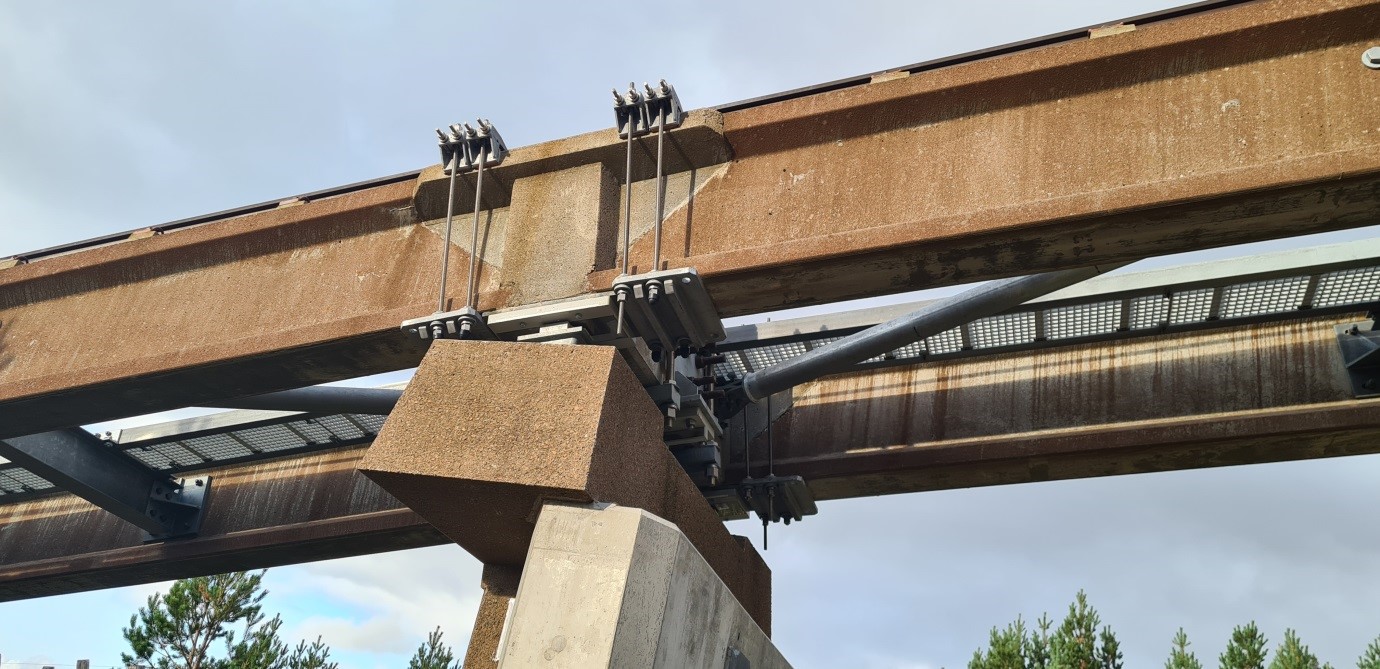
After my last post I had conversations with a couple of people about my conclusions that the insitu stitch/ joints are the wrong way up, i.e. instead of the joint being wedge shaped, as in the picture above, it should be more of a pyramid, as in my drawing below.
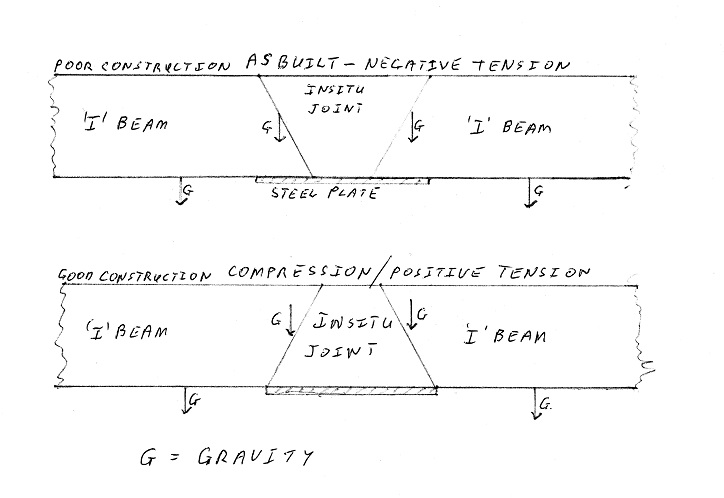
There were a number of civil engineers who supported my theory and two that didn’t. I am not a civil engineer so at times I struggle to understand the technical information that they use, it’s like trying to do a degree course in weeks/ months rather than years and understanding a lifetime of experience.
The case against my argument that the scarf joints should have been formed the other way up was:-
(A) The joint would be hard to form
Because of the length of the bottom of the in-situ joint the mould would need either,
(1) A strengthened steel plate longer than the distance between the ends of the “I” beams, probably strapped to the “I” beams to support it, or,
(2) If a shorter plate, as in the original design, was used the rest of the joint would require substantial support underneath because of the weight of concrete pressing down. That “solution” would also leave the lower corners of the pyramid joint unsupported when completed.
(B) The joint would be weak.
When pouring the concrete into the pyramid shaped mould it would tend to slump away from the “I” beams and air could be trapped between the new concrete and the “I” beams bweakening the structure and allowing water ingress (see description of a cold join below). But that is exactly what is happening with the wedge shaped insitu as confirmed by the next screenshot from the ADAC Structures report of July 2018:-
“2 The majority of precast beams have slightly larger cracks at their junction with the in−situ concrete of the crossheads. Usually the cracks are larger at the upper flange, tapering to zero by mid−web. Typical crack widths vary upto 1.0mm, with an average of 0.5mm. In a significant number of cases, these cracks are associated with rust−coloured deposits on the surface of the precast concrete web, indicating that some corrosion has occurred of the reinforcing steel which originally protruded from the precast beam prior to being surrounded by in−situ concrete.
BS 8110−2 section 3 clause 3.2.4.2 states that to prevent corrosoin in aggressive environments the crack width should not exceed 0.3mm. There are many instances where this limit is exceeded and it is no surprise that rust staining is being seen.
The possibility of ongoing corrosion of the reinforcing steel should be considered, together with the long−term consequences of this, should it be left uncorrected. It is recommended that measures should be taken to seal any cracks where rust−staining is apparent, so as to eliminate oxygen and water ingress.
A detailed assessment of what has caused this cracking has not been carried out, but it seems likely that there is more than one cause.”
While self – compacting concrete would overcome the problems in (B), the more awkward problem is (A). I therefore partly agree with the people who were against my original argument, not that it wouldn’t work as that depends on the quality of workmanship (as shown in the photo and comments below), but that it would be a lot more awkward, labour intensive and therefore expensive especially in a mountain environment. Of course, all these points would have been academic if the “I” beams had been pre-stressed when they were made.
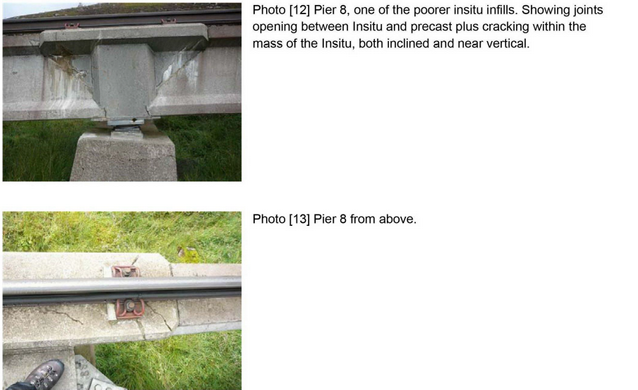
Having said that, there is a third option, the beams could have been made with straight, vertical ends, as shown below,
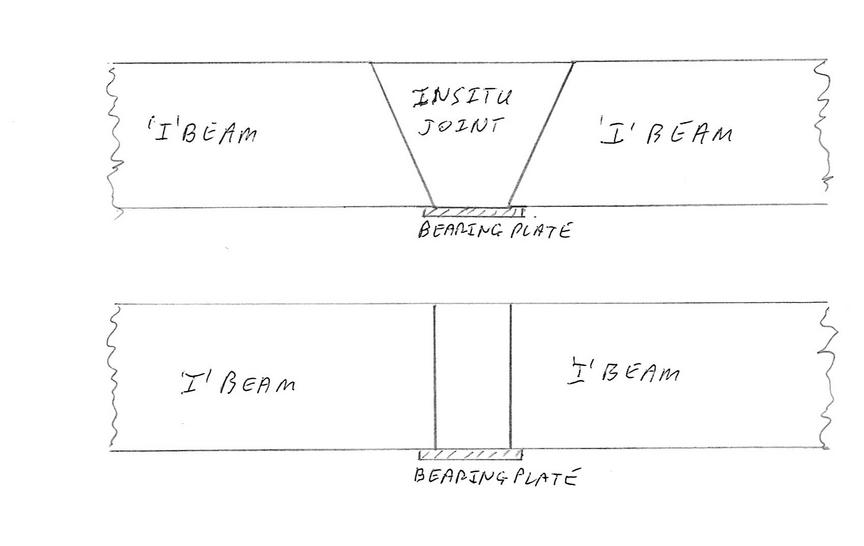
A rectangular insitu joint would have been much easier and cheaper to form than either the wedge or the pyramid and appears to be what Balfour Beatty have done at Pier 51 at the passing loop as shown below.
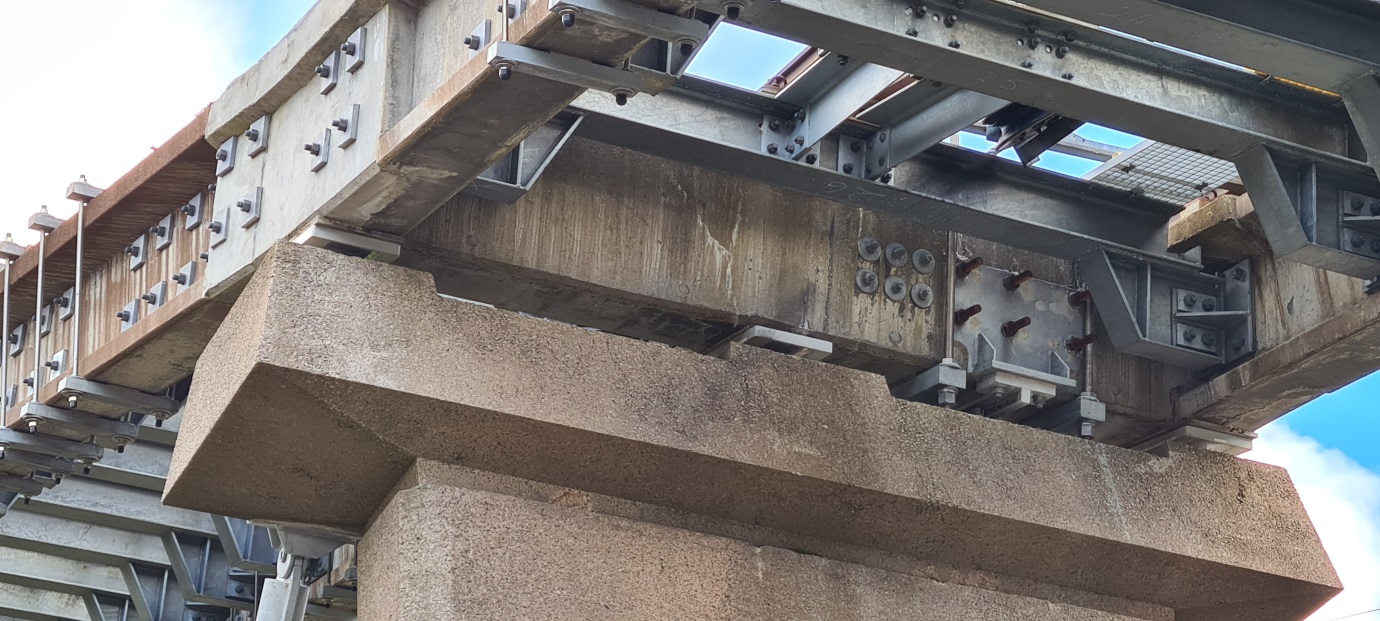
This joint may be not as pleasing visually but probably more effective.
Not one of these options for joints is a good idea as they are all known as “cold” joints. The screenshot is from this link:- https://www.structuralguide.com/cold-joint-concrete/.
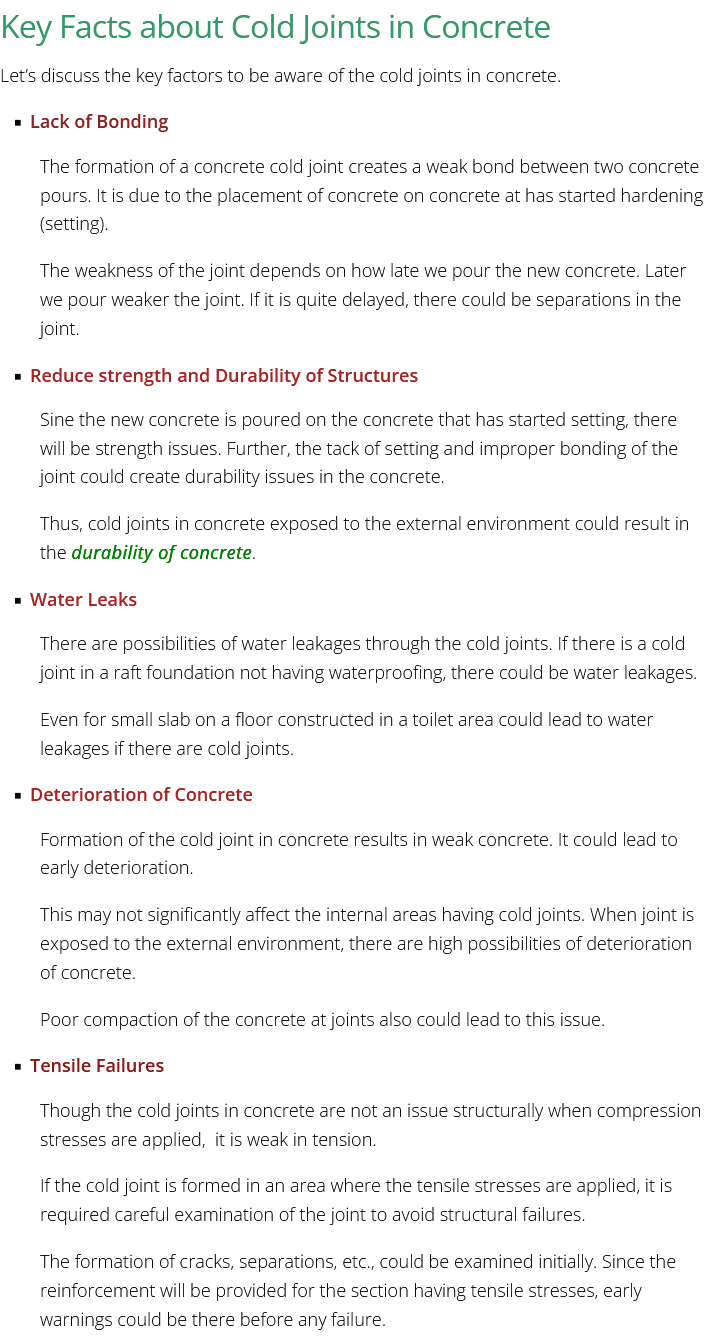 NOTE the last three sentences which possibly explain the current problems with the funicular.
NOTE the last three sentences which possibly explain the current problems with the funicular.
My second conversation with civil engineers was enlightening, exposing yet more flaws in using concrete for the “I” beams.
The temperature range on Cairn Gorm can vary between -29C and + 30C and because of this the steel reinforcing in the “I” beams will expand and contract more than the concrete. This has the effect of destroying the tensioning within the beams. Micro cracks will start to appear ,allowing water ingress to start corroding the steel work. These micro cracks will then increase in size due to the freeze/ thaw process.
The beam above Pier 51,see photo below, is an example of how quickly the size of these cracks can become a major problem, increasing from a few centimetres in 2016 to half its length in July 2017.

“5 Conclusions:
5.1 It was concluded that the observed crack were a developing situation, due to the fact that it was only first noticed in 2016 and that the calcite bleed is more developed at one end.
5.2 It is thought that the problem is a latent defect within the original fabrication of the beams, most likely due to a cold joint within the concrete pour.
5.3 It was concluded that there is no imminent danger of the beams collapsing.
5.4 If left the beams will continue to deteriorate and stability issues would arise.”
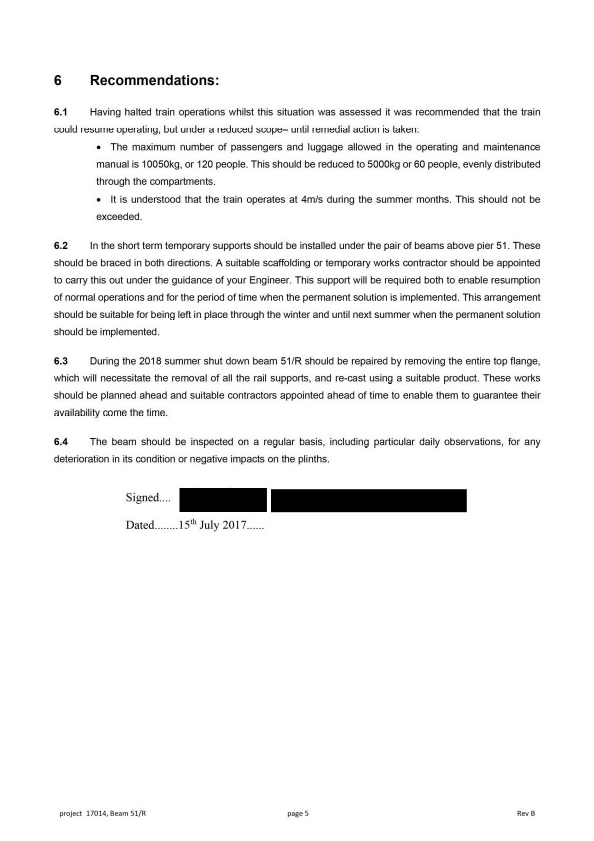
While cracks can also occur in a steel structure they are usually discovered before they become an issue and can be quickly repaired by welding.
A crack in the vertical plane of one of the concrete “I” beams is unlikely to be noticed and could cause an instant and catastrophic failure of the beam as a carriage crosses it, the result of which you can imagine! Is this next picture of a beam about to collapse? Unless it is an optical illusion that beam has dropped as the train went onto it.
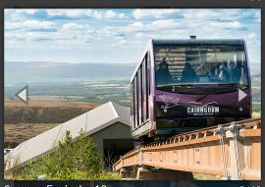
I have been informed by some experts that no construction company would contemplate using concrete in such a hostile environment and yet it was recorded in the Public Audit Report into the funicular in 2010 that Morrison Construction suggested the change from steel to concrete for the “I” beams! If Morrisons didn’t suggest the change in specifications then who did??
Earlier this week it was reported that the funicular will remain out of service for the whole of December and there is no definitive date for re-opening (see here). As all the “snagging and inspection” works have become more and more extended, it increasingly appears the defects in the structure, which have now become a “public safety issue”, are unrepairable. Has someone told HIE that the funicular could cause loss of life if operations are allowed to resume?
If that is the case, HIE is left with three options.
Option 1. Do nothing.
HIE could just leave the funicular as it stands, a white elephant which has so far cost the public purse in excess of £50m. But legally they can’t do that. Part of the conditions for the build was that if the funicular ceases permanent operation then demolition (Option 3) is necessary.
Option 2. Replace the concrete “I” beams with steel.
“Alternatives to strengthening exist. Options include operating under reduced loading after partial strengthening, load testing to reduce the extent of strengthening, and whole or partial replacement of the viaduct.”
(Extract from the COWI report June 2019).
To proceed with this option HIE would again have to go cap in hand to the Scottish Government for yet another multi million pound taxpayer hand out and a further loss of income to the business, Cairngorm Mountain Scotland Ltd while that work is carried out. Three months ago (see here), I costed the steel “I” beams at £7990 per pair. There are 93 bays so a total cost to replace the concrete “I” beams would be approx. £750K. Not much you may think, BUT, that cost will rapidly escalate with the additional cost of new rails, demolition and removal of the concrete “I” beams, labour, transport costs etc.
Option3. Demolish the funicular.
In their heavily redacted business case for the funicular being repaired, the cost of demolition was estimated between £8 – £13m.
The question then arises where would that leave the rest of the business and its employees?
The CM(S)L website recently had this announcement.

Notice there is no mention of using the 13 snow cannon despite them being provided at even more expense to the taxpayer!! Despite the collapse of uplift infrastructure at Cairn Gorm CM(S)L have had ample opportunity to “snow proof” what is left:
(1) the lower slopes by positioning snow cannons in the most useful positions, and,
(2) the Car Park and Fiacaill ridge towpaths using the same matting as plastic slopes.
What does this say about the commitment of the management to the public?
Conclusion.
The implication of the ongoing and unending “snagging” work is that the funicular is beyond repair! HIE are now between a rock and a hard place. A situation of their own making. The taxpayer will have to bail them out whichever option they decide to go for. If thus doesn’t convince the Scottish Government of the need to remove HIE from the mountain and for a judicial enquiry into the funicular farce what will?

It would seem to me (as a retired civil engineer) that the funicular is at a stage where it should simply be deconstructed and the ground around the site restored. It is I fear beyond saving at a reasonable on going cost. It hasbeen a farce from start to finish and the affair should’ve put to rest. After it is gone there can be a serious discussion about the future is snow sports in the area agsinst a backdrop of climate change and if necessary a more robust solution to the issue of ski access in a National Park publicly discussed and if needed implemented in a manner giving due recognition to the hostile environment it is to function in. The present situation is now beyond a joke.
So sad, it was a nice ski resort before the non skiers spent all that money and ruined it. Once they decided they couldn’t let people out of the building at the top of the funicular in Summer they should have scrapped the idea and just renewed the chair lift.
Thanks Graham for all the considerable investigative work you’ve done to expose this debacle. Can there be any doubt now that the Funicular, in its present form, does not have a future? Throwing more good money after bad is no solution to the ails of the CairnGorm Mountain business. Despite an expenditure in excess of £26m since 2018 it seems that it cannot be made to operate reliably. The costs associated with the maintenance requirements are unaffordable and all suggestions of an ongoing public subsidy to support something that simply isn’t worth supporting, need to be abandoned, now.
The Funicular Railway on CairnGorm Mountain has never and will never carry anywhere near the number of passengers that would be required to make it even close to financial sustainability. It is clearly is not something that is necessary to support the local tourism based economy. It’s been out of operation for most of the last 5 years with no noticeable negative impact on the local economy. It’s long past time for a major change of strategy and a good way to begin the process would be to remove HIE from the hill and to fire the present anonymous Board of Directors. The Chairman of the Board of Directors reckons that the ‘facilities on CairnGorm have never been better” Anyone who is deluded to that extent, is clearly unsuited to being a Director, far less the Chairman. The local Community can then get on with the job of resurrecting the hill business with suitable Government sponsored financial guarantees.